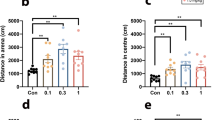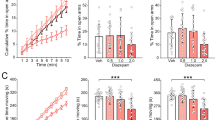Abstract
The effects of ondansetron (0.001–0.1 mg/kg) and the novel 5-HT3 receptor antagonist, WAY 100289 (0.01–10.0 mg/kg), on anxiety were examined in male mice using an ethological version of the elevated plus-maze paradigm. This procedure involves scoring specific aspects of defensive behaviour in addition to the more usual spatiotemporal measures. Results show that, at the doses tested, neither compound produced a behavioural profile consistent with anxiety reduction. Indeed, the lowest dose of ondansetron (0.001 mg/kg) produced some behavioural trends more typically associated with mild anxiety enhancement. Data are discussed in relation to the enigmatic effects of 5-HT3 receptor antagonists in animal models of anxiety. It is suggested that the large within- and between-test variability observed with these compounds may indicate an action on mechanisms other than anxiety.
Similar content being viewed by others
References
Andrews N, File SE (1993) Handling history of rats modifies behavioural effects of drugs in the elevated plus-maze test of anxiety. Eur J Pharmacol 235:109–112
Barrett JE, Vanover KE (1993) 5-HT receptors as targets for the development of novel anxiolytic drugs: models, mechanisms and future directions. Psychopharmacology 112:1–12
Bill DJ, Fletcher A, Glenn BD, Knight M (1992) Behavioural studies on WAY 100289, a novel 5-HT3 receptor antagonist, in two animal models of anxiety. Eur J Pharmacol 218:327–334
Blackburn TP, Baxter GS, Kennett GA, King FD, Piper DC, Sanger GJ, Thomas DR, Upton N, Wood MD (1993) BRL 46470A: a highly potent, selective and long-acting 5-HT3 receptor antagonist with anxiolytic-like properties. Psychopharmacology 110:257–264
Blanchard RJ, Blanchard DC, Rodgers RJ, Weiss SM (1990) The characterisation and modelling of antipredator defensive behaviour. Neurosci Biobehav Rev 14:463–472
Blanchard DC, Blanchard RJ, Rodgers RJ (1991) Risk assessment and animal models of anxiety. In: Olivier B, Mos J, Slangen JL (eds) Animal models in psychopharmacology. Birkhauser, Basel, pp 117–134
Borsini F, Brambilla A, Cesana R, Donetti A (1993) The effect of DAU 6215, a novel 5-HT3 antagonist, in animal models of anxiety. Pharmacol Res 27:151–164
Butler A, Hill JM, Ireland SJ, Jordan CC, Tyers MB (1988) Pharmacological properties of GR 38032F, a novel antagonist at 5-HT3 receptors. Br J Pharmacol 96:269P
Cole JC, Rodgers RJ (1993) An analysis of the effects of chlordiazepoxide and bretazenil (Ro16-6028) in the murine elevated plus-maze. Behav Pharmacol 4:573–580
Cole JC, Rodgers RJ (1994) Ethological evaluation of the effects of acute and chronic buspirone treatment in the murine elevated plus-maze test: comparison with haloperidol. Psychopharmacology 114:288–296
Costall B, Naylor RJ (1991) Anxiolytic effects of 5-HT3 antagonists in animals. In: Rodgers RJ, Cooper SJ (eds) 5-HT1A agonists, 5-HT3 antagonists and benzodiazepines; their comparative behavioural pharmacology. Wiley, Chichester, pp 134–157
Costall B, Naylor RJ (1992) Anxiolytic potential of 5-HT3 receptor antagonists. Pharmacol Toxicol 70:157–162
Costall B, Kelly ME, Tomkins DM, Tyers MB (1989) Profile of action of diazepam and 5HT3 receptor antagonists in the elevated plus-maze. J Psychopharmacol 3:10P
Costall B, Domeney AM, Kelly ME, Tomkins DM, Naylor RJ, Wong EHF, Smith WL, Whiting RL, Eglen RM (1993) The effect of 5-HT3 receptor antagonist, RS-42358-197, in animal models of anxiety. Eur J Pharmacol 234:91–99
Dunn RW, Carlezon WA, Corbett R (1991) Preclinical anxiolytic versus antipsychotic profiles of the 5-HT3 antagonists ondansetron, zacopride, 3α-tropanyl-1H-indole-3-carboxylic acid ester and 1αH, 3α, 5αH-tropan-3-yl-3,5-dichlorobenzoate. Drug Dev Res 23:289–300
Falter U, Gower AJ, Govert J (1992) Resistance of baseline activity in the elevated plus-maze to exogenous influences. Behav Pharmacol 3:123–128
File SE, Johnston AL (1989) Lack of effect of 5-HT3 receptor antagonists in the social interaction and elevated plus-maze tests of anxiety in the rat. Psychopharmacology 99:248–251
Gao B, Cutler MG (1992) Effects of acute administration of the 5-HT3 receptor antagonist, BRL 46470A, on the behaviour of mice in a two compartment light-dark box and during social interactions in their home cage and an unfamiliar neutral cage. Neuropharmacology 31:743–748
Glenn B, Green S (1989) Anxiolytic profile of GR 38032F in the potentiated startle paradigm. Behav Pharmacol 1:91–94
Greenshaw AJ (1993) Behavioural pharmacology of 5-HT3 receptor antagonists: a critical update on therapeutic potential. Trends Pharmacol Sci 14:265–270
Handley SL, McBlane JW (1993a) An assessment of the elevated X-Maze for studying anxiety and anxiety-modulating drugs. J Pharmacol Toxicol Methods 29:129–138
Handley SL, McBlane JW (1993b) Serotonin mechanisms in animal models of anxiety. Brazil. J Med Biol Res 26:1–13
Hoyer D (1992) Agonists and antagonists at 5-HT receptor subtypes. In: Bradley PB, Handley SL, Cooper SJ, Key BJ, Barnes NM, Coote JH (eds) Serotonin, CNS receptors and brain function. Pergamon, Oxford, pp 29–47
Humphrey PPA, Hartig P, Hoyer D (1993) A proposed new nomenclature for 5-HT receptors. Trends Pharmacol Sci: 14:233–236
Johnston AL, File SE (1988) Effects of ligands for specific 5-HT receptor subtypes in two animal tests of anxiety. In: Lader M (ed) Buspirone: a new introduction to the treatment of anxiety Royal Society, London, pp 31–41
Jones BJ, Costal B, Domeney AM, Kelly ME, Naylor RJ, Oakley NR, Tyers MB (1988) The potential anxiolytic activity of GR 38032F, a 5-HT3 receptor antagonist. Br J Pharmacol 93:985–993
Lee C, Rodgers RJ (1990) Antinociceptive effects of the elevated plus-maze: influence of opiate receptor manipulations. Psychopharmacology 102:507–513
Lister RG (1987) The use of a plus-maze to measure anxiety in the mouse. Psychopharmacology 92:180–185
Middlefell VC, Price TL, Asprey FE, Wong MWK, Thomson IA (1991) The in vivo pharmacology of WAY 100289 — a novel 5-HT3 receptor antagonist. Fundam Clin Pharmacol 5:462–466
Middlemiss DN, Tricklebank MD (1992) Centrally-active 5-HT receptor agonists and antagonists. Neurosci Biobehav Rev 16:75–82
Morinan A (1989) Effects of the 5-HT3 receptor antagonists GR 38032F and BRL 24924 on anxiety in socially isolated rats. Br J Pharmacol 97:457P
Mos J, Van der Heyden JAM, Olivier B (1989) Behavioural effects of 5-HT3 antagonists in animal models for aggression, anxiety and psychosis. In: Bevan P Cools AR, Archer T (eds) Behavioural pharmacology of 5-HT. Erlbaum Hillsdale NJ, pp 389–395
Moser PC (1989) An evaluation of the elevated plus-maze using the novel anxiolytic buspirone. Psychopharmacology 99:48–53
Papp M, Przegalinski E (1989) The 5-HT3 receptor antagonists ICS 205–930 and GR 38032F, putative anxiolytic drugs, differ from diazepam in their pharmacological profile. J Psychopharmacol 3:14–20
Piper D, Upton N, Thomas D, Nicholson J (1988) The effects of the 5-HT3 receptor antagonists BRL 43694 and GR 38032F in animal behavioural models of anxiety. Br J Pharmacol 94:314P
Prather PL, Rezazadeh SM, Lane JD, Rowan GA, Hooper ML, Lytle DA, Emmett-Oglesby MW, Lal H (1993) Conflicting evidence regarding the efficacy of ondansetron in benzodiazepine withdrawl. J Pharmacol Exp Ther 264:622–630
Rhodes KF, Middlefell VC, Lattimer N, Brammer NT, Coleman J, Taylor AP, Saville VL, Ward TJ (1993) WAY 100289: pharmacological profile of a novel 5-HT3 receptor antagonist. Drug Dev Res 28:128–140
Rodgers RJ (1991) A step in the right direction. Comment on “5-HT and mechanisms of defence”. J Psychopharmacol 5:316–319
Rodgers RJ, Cole JC (1993a) Anxiety enhancement in the murine elevated plus-maze by immediate prior exposure to social stressors. Physiol Behav 53:383–388
Rodgers RJ, Cole JC (1993b) Influence of social isolation gender, strain and prior novelty on plus-maze behaviour in mice. Physiol Behav 54:729–736
Rodgers RJ, Cole JC (1994) The elevated plus-maze: pharmacology, methodology and ethology. In: Cooper SJ, Hendrie CA (eds) Ethology and psychopharmacology. Wiley, Chichester (in press)
Rodgers RJ, Shepherd JK (1992) Attenuation of defensive analgesia in male mice by 5-HT3 receptor antagonists, ICS 205–930, MDL 72222, MDL 73147 and MDL 72699. Neuropharmacology 31:553–560
Rodgers RJ, Shepherd JK, Randall JI (1990) Highly potent effects of 5-HT3 anxiolytic, GR 38032F, on defeat analgesia in mice. Neuropharmacology 29:17–23
Rodgers RJ, Cole JC, Cobain MR, Daly P, Doran PJ, Eells JR, Wallis P (1992) Anxiogenic-like effects of fluprazine and eltoprazine in the mouse elevated plus-maze: profile comparisons with 8-OH-DPAT, CGS 12066B, TFMPP and mCPP. Behav Pharmacol 3:621–634
Rodgers RJ, Cole JC, Davis A (1994) Anti-anxiety and behavioural suppressant actions of the novel 5-HT3 receptor agonist, flesinoxan. Pharmacol Biochem Behav 48:959–963
Shepherd JK, Rodgers RJ, Blanchard RJ, Magee LK, Blanchard DC (1993) Ondansetron, gender and antipredator defensive behaviour. J Psychopharmacol 7:72–81
Taylor DP, Moon SL (1991) Buspirone and related compounds as alternative anxiolytics Neuropeptides 19 [suppl. 1]:15–19
Treit D, Menard J, Royan C (1993) Anxiogenic stimuli in the elevated plus-maze. Pharmacol Biochem Behav 44:463–469
Tricklebank MD (1993) Central serotonin receptors and psychotropic drugs. Trends Pharmacol Sci 16:161–162
Vasar E, Peuranen E, Oopik T, Harro, J, Mannisto PT (1993) Ondansetron, an antagonist of 5-HT3 receptors, antagonizes the antiexploratory effect of caerulein, an agonist of CCK receptors, in the elevated plus-maze. Psychopharmacology 110:213–218
Wright IK, Heaton M, Upton N, Marsden CA (1992) Comparison of acute and chronic treatment of various serotonergic agents with those of diazepam and idazoxan in the rat elevated X-maze. Psychopharmacology 107:405–414
Author information
Authors and Affiliations
Rights and permissions
About this article
Cite this article
Rodgers, R.J., Cole, J.C. & Tredwell, J.M. Profile of action of 5-HT3 receptor antagonists, ondansetron and WAY 100289, in the elevated plus-maze test of anxiety of mice. Psychopharmacology 117, 306–312 (1995). https://doi.org/10.1007/BF02246105
Received:
Revised:
Issue Date:
DOI: https://doi.org/10.1007/BF02246105




